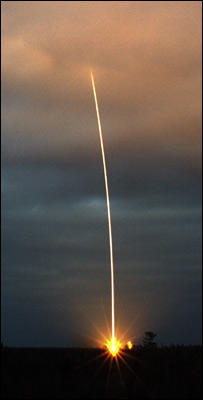
Europe ice mission failure probed
Space agencies are investigating why a rocket carrying a European mission to map polar ice fell into the ocean
By Helen Briggs
BBC News
10-9-05
The European Space Agency's Cryosat spacecraft was lost minutes after lift-off from the Plesetsk Cosmodrome in northern Russia on Saturday evening.Space agencies are investigating why a rocket carrying a European mission to map polar ice fell into the ocean
By Helen Briggs
BBC News
10-9-05
Russian officials say an error caused the rocket's second stage to run out of fuel, so it could not eject the probe.
The £90m (135m euro) craft was designed to monitor how the Earth's ice masses are responding to climate change.
The Esa satellite was launched at 1902 local time (1602 BST) on Saturday.
But mission controllers failed to make contact with the spacecraft as planned some two hours later.
Russian space officials said that both the spacecraft and the two top parts of its rocket had fallen into the Arctic Ocean, north of Greenland.
The satellite was launched on a Rockot vehicle - a converted SS-19 intercontinental ballistic missile.
The rocket, which in the Cold War would have been armed with nuclear weapons, had been modified with the addition of a Breeze-KM upper stage.
Early indications suggest that a problem with the two lower stages of the rocket, specifically a missing command from the onboard flight system, caused the mission to fail.
Reports from Moscow say that further Rockot launches have been put on hold while an investigation is carried out.
The loss of Cryosat brings an uncertain future for the teams of scientists and engineers working on the mission.
It was proposed in 1998 by Duncan Wingham of University College London, to provide more reliable data on climate change.
Cryosat had a main mission goal of studying the sea ice in the Arctic Ocean, which appears to be thinning rapidly. He said there was no other satellite like it on the books.
"Space is a risky business, it always has been, it doesn't always go perfectly," he said. "We just have to think about where we go from today."
Any moves to rebuild the mission now rest on funding.
Ministers from member states must decide in December how much money to commit to Esa's science programme.
But any "Cryosat 2" will face stiff competition from other projects such as a future robotic mission to Mars.
Mark Drinkwater, Cryosat mission scientist at Esa, said there was an urgent need to formulate a plan on whether it was possible to rebuild Cryosat.
"I hope that we can convey the message that this is a fundamentally important mission and that we can in some way recover the situation," he told the BBC News website.
"But I think it would be right to say that we would be looking at a minimum of two to three years to recover the situation particularly in view of the fact that we also have to reconsider the situation with the launch vehicle."
Cryosat was to be the first in a series of Earth Explorer missions planned by Esa. The satellite missions are designed to be quicker and cheaper than their predecessor, Envisat, a giant earth-monitoring satellite which took more than a decade to build.
The second Earth Explorer, a satellite to measure the earth's gravitational field, is due to be launched on a Rockot vehicle next year.
The launcher had flown six successful missions before the loss of Cryosat, its first Esa payload.
More . . .
Home
No comments :
Post a Comment
Dear Reader/Contributor,
Your input is greatly appreciated, and coveted; however, blatant mis-use of this site's bandwidth will not be tolerated (e.g., SPAM, non-related links, etc).
Additionally, healthy debate is invited; however, ad hominem and or vitriolic attacks will not be published, nor will "anonymous" criticisms. Please keep your arguments/comments to the issues and subject matter of this article and present them with civility and proper decorum. -FW